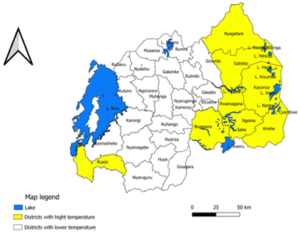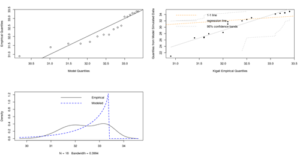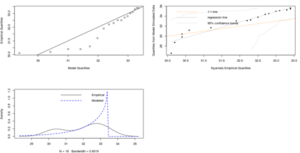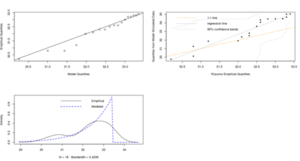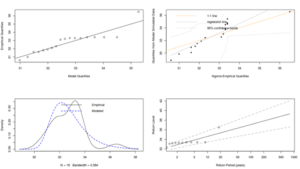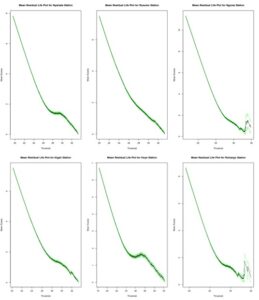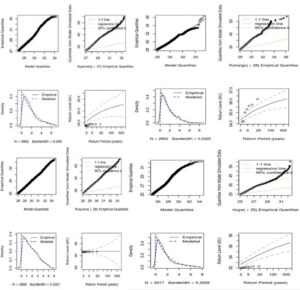Open Journal of Mathematical Sciences
Vol. 7 (2023), Issue 1, pp. 180 – 195
ISSN: 2523-0212 (Online) 2616-4906 (Print)
DOI: 10.30538/oms2023.0206
Statistical modelling of maximum temperature in Rwanda using extreme value analysis
Edouard Singirankabo\(^{1.*}\), Emmanuel Iyamuremye\(^1\), Alexis Habineza\(^2\) and Yunvirusaba Nelson\(^2\)
\(^1\) Department of Mathematics, College of Education, University of Rwanda, Rwanda.
\(^{2}\) Department of Mathematics, Jomo Kenyatta University of Agriculture and Technology, Kenya.
Correspondence should be addressed to Edouard Singirankabo at nkabo12edus@gmail.com
Abstract
Keywords:
1. Introduction
Climate extremes negatively impact our lives through droughts, floods, landslides and ecological disturbances, as they affect human activities and the economy. Human beings are weather sensitive. The weather attracts people’s attention especially unusual or extreme weather events, due to enormous economic or human impact [1]. The temperature on earth changes as a consequence of human activities such as burning fossil fuel smokes from industries, deforestation, urbanization due to rapid population growth, having a lot of plastic bags in the soil, and many others that are the main cause of the extreme temperature of the climate system [2]. Extreme temperatures provided by increasing concentrations of greenhouse gases are natural phenomena that affect daily human activities, including damaging agricultural production, causing drought with hunger as it’s an effect, and loosing lives of people, animals, and different categories of plants [3,4,5, 6].
All statistical analyses focused on climate studies in Rwanda have used the mean temperature as one of the main variables, for example, the study conducted by Hakizimana [7] and Havugimana [8]. However, the statistical behaviour of climate extremes has become increasingly considered in recent years, and climate extremes are estimated to have more significant negative impacts on human society and the natural environment than the changes in mean climate. The probabilities for rare events more significant (or smaller) than previously recorded events are predicted using Extreme Value Theory (EVT), especially the Peaks Over Threshold method. Under EVT, two approaches are used to model and analyze the data with extreme values; the block maxima (BM) method, by which minimum or maximum values are distributed as a Generalized Extreme Value Distribution (GEVD), and the Peaks Over Threshold (POT), by which values exceeding a high threshold are distributed as a Generalized Pareto distribution (GPD). EVT was developed to model and assess the risks caused by extreme events [9]. It is now being used in many disciplines, including engineering, sciences, actuarial sciences, statistics, meteorology, hydrology, ecological disturbances, finance, and many others. In the past few years, EVT has been used in several types of research concerning extreme climatic events such as [1,4,10,11,12] among others. Although some works on climate extremes modelling have been done, studies related to extreme temperatures in Rwanda have yet to be done. Therefore, the significance of this study is based on the fact that the agricultural (e.g., crop productions) and many economic activities heavily depend on climatic conditions.
2. Problem Statement
In the 21st century, the world has experienced numerous challenges due to global warming and environmental degradation. Scientists have predicted the excessive diminution of rainfall and global increase in temperature from \(1.4^{0}C\) to \(5.8^{0}C\) by the end of the 21st century because of the increase in the concentration of greenhouse gases [13, 14]. This rainfall diminution and increase in temperature have huge effects on the ecosystems. However, they directly impact felt by communities that depend on rainwater to cultivate and get agricultural products. It affects crop growth and development, which reduces crop yield and quality. In addition, extremely high temperatures and prolonged heat waves can increase energy and water consumption, severely affect human well-being, health, and even cause loss of human lives [1]. Rwanda does not make any exception to this reality. Rwanda, as a developing country without many natural resources, whose economy strongly depends on rain-fed agriculture, has been challenged by extremely high temperatures. For example, 1750 cows died in Nyagatare District due to a lack of fodder and water in 2015 [7]. Between 2015 and 2016, crops on 16,119 hectares of land in Kayonza District, 11,012 hectares in Nyagatare District and 750 hectares in Kirehe District were affected by drought, resulting in famine throughout the Eastern Province, and more than 47,300 households were affected [15]. Thus, extreme value theory is used to access the results, providing critical information about Rwanda's extreme temperatures. The findings will give insight to the farmers, researchers and local governments, and others who can use them to propose mitigating measures to increase resilience and prepare the general public for changes due to extreme temperatures in the nearest future.3. Objective
The aim of this study is to model the statistical behaviour of extreme maximum values of temperature in Rwanda. This aim is achieved through the following objectives:- To determine the appropriate distribution for the tails of the distributions of temperature under extreme value theory framework
- To assess the return periods of extreme temperature and their corresponding return levels
4. Literature
4.1. The concept of extreme value analysis
Extreme value analysis (EVA) is a statistical tool to estimate the likelihood of the occurrence of extreme values based on a few basic assumptions and observed/measured data [16]. It is the branch of statistics devoted to the inference of extreme events in random processes and differs from most areas of statistics in modelling rare rather than typical behaviour. It is used to deal with extreme deviations from the median of probability distributions. To evaluate the risk of extreme events in EVA, extreme value models are formulated based on fitting a theoretical probability distribution to the observed extreme value series [17]. Under EVA, two extreme value methods are applied, the block maxima (BM) method and the peak over threshold (POT) method. Two fundamental distributions in EVA, Generalized Extreme Value distribution (GEVD) by Jenkinson [18]16a} and Generalized Pareto distribution (GPD) by [19] and [20], were developed. When extreme values are studied under the BM method, the extreme observations follow the GEVD, and under the POT method, the exceedances follow a GPD. Currently, EVA is used in modelling extreme temperature and rainfall events, significant insurance losses, day-to-day market risk, road safety analysis, wireless communications, structural engineering, finance, earth sciences, traffic prediction and geological engineering. A common aim is to estimate what future extreme levels of a process might be expected based on a historical series of observations [21].4.2. Extreme temperature modelling
Extreme value analysis has been used by different researchers all over the world in modelling extreme temperatures. Diriba et al., [22] argued that using the generalized Pareto distribution (GPD) found an increase in extremes of daily maximum temperature and daily minimum temperature in South Africa. Previously Chikobvu and Sigauke [23] modelled daily minimum temperature in South Africa using the generalized extreme value distribution (GEVD). Because GEVD may exclude extensive observations from the analysis, GPD was recommended. Under the extreme value analysis framework, block maxima and threshold exceedances were employed in modelling extreme temperatures in Saudi Arabia. The generalized Pareto distribution model proved better than the generalized extreme value distribution [24]. The study showed that new records on maximum temperature events could appear within the next 20, 50 and 100 years.5. Methodology
5.1. Area of the study
Rwanda is a small landlocked nation located in the Great Lakes region of East Africa. It is at \(02^{0}.00\) latitude south and \(30^{0}.00\) longitude East. It borders Burundi (South), Tanzania (East), Uganda (North) and the Democratic Republic of Congo (DRC) (West). Rwanda has a mild and tropical climate, with temperatures varying across the year, with two maxima and two minima [25]. The average temperature is about 200C, and the topography varies. The warmest temperature is found in the eastern plateau and the south-eastern Rusizi Valley (in the western part of the country) between \(20^{0}\)C and \(21^{0}\)C. The cooler temperatures are found in higher elevations of the central plateau between \(17.5^{0}\)C and \(19^{0}\)C and highlands \((< 17^{0}\)C) in the North of the country. Warner et al., [26] presented in their report the areas in Rwanda mostly facing the risks of droughts. Areas in Rwanda are particularly vulnerable to the devastating impacts of droughts, which have become increasingly frequent and severe in recent years. Climate change is exacerbating this problem, as rising temperatures and changing rainfall patterns are disrupting agricultural productivity, causing water scarcity, and increasing the risk of wildfires. Urgent action is needed to address this pressing issue and develop effective strategies to mitigate the impacts of droughts and promote sustainable development in the affected regions, see Figure 1.Figure 1. Areas in Rwanda mostly facing the risks of droughts
5.2. Data description
The daily temperature data was recorded from 9 weather stations collected by the Rwanda Meteorological Agency (RMA) between 2000 and 2017. Those stations are randomly distributed with different temperature patterns and geographical locations due to the area of Rwanda. We analysed the data station by station; the ones with shorter records or high missing data were left out. Unlike statistical analyses regarding climate studies in Rwanda that have used the mean temperature as one of the main variables, this study used extreme value analysis to model the statistical behaviour of extreme temperature. Therefore, annual extreme values were extracted from the daily temperature data from 9 stations and new data set was formed. Under this study uses two methods, the block maxima (BM) method and the Peaks Over Threshold (POT), to model and analyse extracted extreme values.5.3. Block maxima (BM) and generalized extreme value distribution (GEVD)
Using the BM method, a sample is divided into equal time intervals [27,28], and a set of maximum/minimum observations from each interval constitutes a sample of extremes [1, 29]. Given a sequence of independent and identically distributed random variables \(X_{1m}, X_{2m},..., X_{nm}\) from a time interval, the maximum values are defined as \(M_n=max(X_{1m}, X_{2m},...,X_{nm})\) having a joint distribution function F. The distribution of those maximum values is the Generalized Extreme Value (GEV) distribution: \begin{equation}\notag G(x,\mu,\delta,\xi)=\exp\left[ -\left(1+\xi\left(\frac{x-\mu}{\delta}\right) \right)\right]^{\frac{-1}{\xi}}\,, \end{equation} where \(x\) are the extreme values from the blocks, \(\mu\) a location parameter; \(\delta\) a scale parameter; and \(\xi\) a shape parameter. Referring to the value of shape parameter, the Generalized Extreme Value Distribution has three basic forms, each corresponding to a limiting distribution of maximum values from a different class of underlying distributions. If \(\xi>0\), tails decrease as a polynomial, leading to Fréchet distribution. While \(\xi< 0\), tails are finite, leading to Weibul distribution. A special case is the Gumbel distribution when \(\xi\to 0\): \begin{equation}\notag G(\mu,\delta)=\exp\left[ -\exp\left(-\left(\frac{x-\mu}{\delta}\right) \right)\right]\,. \end{equation}Peak over threshold (POT) and generalized Pareto distribution (GPD)
One of the methods used to analyze the distribution of extreme events is Peak over Threshold (POT), which considers the maximum variables exceeding a predetermined threshold [20]. In this method, a threshold \(u\) is first fixed, and all data above it are considered extremes. Then, those extreme values of a sample over a chosen threshold are studied by modelling their tail behaviours using the conditional distribution of these exceedances. For example, given that the temperature in Rwanda exceeds a high threshold, let us say \(u\), by how much can \(u\) be exceeded? To answer such a question, we need the Excess Distribution, which is approximated to GPD under Peak Over Threshold (POT) framework. For some sufficiently large threshold \(u\), the distribution of the excess values approximates a Generalized Pareto Distribution with a shape parameter; for some sufficiently large threshold \(u\), the distribution of the excess values approximates a Generalized Pareto Distribution with a shape parameter, \(\xi\) and a scale parameter, \(\delta_u\). Let denote the threshold and \(X\) be a random variable with distribution function \(F\). Then, the exceedances distribution function over the threshold \(u\) is given by \begin{equation}\tag{1} F_{u}(x)=\frac{F(u+x)-F(u)}{1-F(u)}\;if\;X>u,X\geq 0\,. \end{equation} By letting \(Y_i=X_{i}-u\), then the distribution of the exceedances \(Y_1,Y_2,Y_3,...,Y_{nu}\) can be approximated by a Generalized Pareto Distribution with a shape parameter, \(\xi\) and a scale parameter, \(\delta_u\) [20] defined as: \begin{equation}\tag{2}\label{eq2} G(x-\mu,\delta_{u},\xi)=1-\left[1+\xi\left(\frac{x-\mu}{\delta_{u}}\right)\right]^{\frac{-1}{\xi}} \,.\end{equation} Depending on the value of shape parameter, the Generalized Pareto Distribution has three basic forms, each corresponding to a limiting distribution of excess values from a different class of underlying distributions. A special case of Eq. (\ref{eq2}) for \(\xi\to 0\) is the exponential distribution: \begin{equation}\tag{3} G(x-\mu,\delta_{u})=1-\exp\left[ -\left(\left(\frac{x-\mu}{\delta_{u}}\right)\right)\right]\,. \end{equation} The other two cases of Eq. (\ref{eq2}) for \(\xi\neq0\) are as follow:- If \(\xi >0\), tails decrease as a polynomial, leading to Pareto Distribution.
- If \(\xi< 0\), tails are finite, leading to Beta Distribution.
5.4. Return levels estimation
When the best model for the data is found, the interest is to derive the return levels of maximum temperature. It is vital to evaluate return levels, \(X_T\), for example, the T-year return level, which is exceeded once every T years. The return level of an extreme event, defined as the value \(X_T\), is expected to be exceeded on average once every T year (T is called the return period, that is, the period expressed in years by which the annual observation is expected to return). Let \(Y_T\) represent extreme values of a random variable, such that there is a probability T, that \(Y_T\) is exceeded in any given year. The return level related to the return period \(\frac{1}{T}\) is the level that, on average, is expected to be exceeded once every \(\frac{1}{T}\) years. Let \(X_T\) present the level of exceeded temperature on average only once in T years return level \(X_T=1-\frac{1}{T}\) [30]. In this paper, return levels for both GP and GEV models were estimated and compared.5.4.1. Return levels estimation for generalized Pareto distribution
Once the GPD is selected as a suitable model for exceedances, then the probability of the exceedances of a variable X over a suitable high threshold \(u\) is \(P(X>x/X>u\) Applying properties of conditional probability and let \(P(X>u)=\tau_u\) to get \(P(X>x)=\tau_u P(X>x/X>u)=\tau_u[1-G(x-u,\delta_u,\xi)]\) which leads to \begin{equation}\tag{4}\label{eq4} P(X>x)=\tau_{u}\left[1+\xi\left(\frac{x-\mu}{\delta_u}\right)\right]^{\frac{-1}{\xi}} \,.\end{equation} Therefore, the amount by which an event exceeds the threshold \(u\) in T-year is obtained by defining \(x_T\) in Eq. (\ref{eq4}) by \(P(X>x_T)=\frac{1}{T}\) and then solve for \(x_T\) Hence, the T-year return level is defined by: \(X_T=u+\frac{\delta_u}{\xi}[T\tau_u]^{\xi}-1\), if \(\xi\neq0\) and \(X_T=u+\delta_u\log(T\tau_u)\), if \(\xi=0\) with \(\tau_u,\) \noindent the probability of the occurrence of an exceedance of a high threshold \(u\) .5.4.2. Return levels estimation for generalised extreme value distribution
The return level for the GEV model with the return period \(\frac{1}{T}\) is given by [4, 31], \begin{equation}\notag X_T= \left\{ \begin{array}{cc} \mu-\frac{\sigma}{\xi}\{1-[-\log(1-T)]^{\xi}\} & \xi\neq0\\ \mu-\delta\log[1-(-\log(1-T))] & \xi=0 \end{array}\right. \end{equation} The level \(X_p\) is expected to be exceeded on average one every \(\frac{1}{T}\) years.5.5. Parameter estimation
Considering its consistency, efficiency, asymptotic behaviour, this paper used the method of maximum likelihood estimation (MLE) to estimate GP and GEV parameters. Adaptability of the MLE to changes in model structure as compared to other parameter estimation techniques makes it preferable.5.5.1. Parameter estimation of generalised Pareto distribution
Let \(Y_1,Y_2,Y_3,...,Y_m\) be a sequence of m excesses of a threshold \(u\). The likelihood function from Eq. (\ref{eq2}) is, \begin{equation}\notag L(y_i,\delta_u,\xi)=\Pi_{i=1}^{n}g(y_i,\delta_u,\xi)\;with\;g(y,\delta_u,\xi)=\frac{d}{dy}G(y,\delta_u,\xi)\,. \end{equation} For \(\xi\neq0\) , the log-likelihood of GPD is \begin{equation}\notag l(y_i,\delta_u,\xi)=-m\log\delta_u-\left(1+\frac{1}{\xi}\right)\sum_{i=1}^{m}\log\left(1+\frac{\xi y_i}{\delta_u} \right)\,, \end{equation} and \begin{equation}\notag l(y_i,\delta_u)==-m\log\delta_u-\frac{1}{\delta_u}\sum_{i=1}^{m}(y_i)\,. \end{equation} For \(\xi=0\). The values \(\delta_u\) and \(\xi\) are the estimation parameters which maximize Eq. (\ref{eq2}).5.5.2. Parameter estimation of generalised extreme value distribution
Let \((Y_1,Y_2,Y_3,...,Y_k)\) be a random sample of the random variable \(Y\) taken from a GEVD. The log-likelihood function for \(\xi\neq0\) of observed random sample \((Y_1,Y_2,Y_3,...,Y_m)\) is given by, \begin{equation}\tag{5} l\left(\mu,\delta,\sfrac{\xi}{X_1},\ldots,X_m\right)=-mlog\delta-\left(1+\frac{1}{\xi}\right)\sum_{i=1}^{m}log\left(1+\xi\left(\frac{X_i-\mu}{\delta}\right)\right)-\sum_{i=1}^{m}\left(1+\xi\left(\frac{X_i-\mu}{\delta}\right)\right)^\frac{-1}{\xi}\,, \end{equation} provided that \(1+\xi\left(\frac{X_i\mu}{\delta}\right)>0,i=1,2,...,m\). However, when \(\xi=0\) the log-likelihood function becomes \begin{equation}\tag{6}\label{eq5} l(\mu,\delta,\xi/X_1,...,X_m)=-m\log\delta-\sum_{i=1}^{m}\exp\left(\frac{-X_i-\mu}{\delta}\right)-\sum_{i=1}^{m}\left(\frac{X_i-\mu}{\delta}\right)\,. \end{equation} The MLE for the unknown parameters \(\mu,\delta,\xi\) were found by maximizing Eq. (\ref{eq5}). Hence, these equations have been solved by numerical or iteratively methods [32].6. Numerical results and discussion
This section gives statistical results from the analysis. Table 1 below shows the descriptive measures for the annual maximum temperature at various stations. First, the annual maximum temperatures were obtained by extracting the highest value from the daily temperature in a year, then using R software; basic descriptive statistics were defined.Table 1. Basic descriptive statistics of annual maximum temperature.
| N | Station | Min | Mean | Max | Standard deviation | Shapiro-Wilk Test |
|---|---|---|---|---|---|---|
| 1 | Kigali | 30.9 | 32.43 | 33.4 | 2.079 | 0.92 (0.013) |
| 2 | Rwamagana | 30.2 | 32.08 | 33.4 | 2.013 | 0.91 (0.09) |
| 3 | Huye | 26.7 | 30.08 | 32.3 | 1.978 | 0.88 (0.036) |
| 4 | Ruhango | 30.1 | 32.29 | 36.2 | 2.14 | 0.90 (0.018) |
| 5 | Kibungo | 30.2 | 32.11 | 34.4 | 2.066 | 0.91 (0.11) |
| 6 | Nyamata | 30.1 | 32 | 33.4 | 2.045 | 0.87 (0.02) |
| 7 | Rusumo | 30.2 | 32.31 | 33.4 | 2.363 | 0.88 (0.03) |
| 8 | Ngoma | 30.6 | 32.73 | 36.5 | 2.291 | 0.86 (0.01) |
| 9 | Kirehe | 29.9 | 32.26 | 33.4 | 2.341 | 0.91 (0.98) |
Table 2. Unit root augmented Dickey-Fuller test for maxima temperature.
| Station | Test Statistics | P-value | Conclusion |
|---|---|---|---|
| Kigali | -0.53 | 0.047 | Reject null hypothesis |
| Huye | -3.82 | 0.034 | Reject null hypothesis |
| Ruhango | -2.91 | 0.022 | Reject null hypothesis |
| Nyamata | -4.2 | 0.016 | Reject null hypothesis |
| Rusumo | -3.66 | 0.045 | Reject null hypothesis |
| Ngoma | -0.39 | 0.02 | Reject null hypothesis |
6.1. The block maxima (BM) method
For GEV estimation, the block maxima of daily annual maximum rainfall are extracted for six stations. Daily temperature observations \(X_{1m},X_{2m},...,X_{nm}\) were divided into equal time intervals (m=12 months) and set of maximum observations from each interval constitutes a sample of extremes called “Annual maxima”. The annual maxima \(M_n=max(X_{1m},X_{2m},...,X_{nm})\) were selected. Annual maxima selected from daily temperature is shown in Figure 2.Figure 2. Annual maxima selected from daily temperature
Table 3. GEV parameter estimate for temperature.
| Station | Parameter | Estimates | S.E | C.I |
|---|---|---|---|---|
| Kigali | Location (\(\mu\)) | 32.439 | 0.028 | (32.321, 32.518) |
| Scale (\(\delta\)) | 1.074 | 0.019 | (0.877, 1.271) | |
| Shape (\(\xi\)) | -1.115 | 0.006 | (-1.312, -0.918) | |
| Huye | Location (\(\mu\)) | 30.116 | 2.10-08 | (30.110, 30.118) |
| Scale (\(\delta\)) | 2.438 | 2.10-08 | (2.428, 2.448) | |
| Shape (\(\xi\)) | -1.116 | 2.10-08 | (-1.115, -1.118) | |
| Ruhango | Location (\(\mu\)) | 31.624 | 0.337 | (30.963, 32.285) |
| Scale (\(\delta\)) | 1.234 | 0.25 | (0.744, 1.725) | |
| Shape (\(\xi\)) | -0.047 | 0.207 | (-0.453, 0.359) | |
| Nyamata | Location (\(\mu\)) | 32.186 | 0.28 | (31.156, 32.346) |
| Scale (\(\delta\)) | 1.347 | 0.098 | (0.978, 1.750) | |
| Shape (\(\xi\)) | -1.11 | 0.129 | (-1.305, -0.978) | |
| Rusumo | Location (\(\mu\)) | 32.337 | 0.421 | (30.476, 33.002) |
| Scale (\(\delta\)) | 1.064 | 0.27 | (0.997, 1.232) | |
| Shape (\(\xi\)) | -1.001 | 0.181 | (-1.254, -0.789) | |
| Ngoma | Location (\(\mu\)) | 32.184 | 0.284 | (31.627, 32.742) |
| Scale (\(\delta\)) | 1.09 | 0.198 | (0.702, 1.479) | |
| Shape (\(\xi\)) | -0.072 | 0.142 | (-0.350, 0.205) |
Table 4. Estimated parameters for Gumbel model.
| Station | Parameter | Estimates | S.E | C.I |
|---|---|---|---|---|
| Pruhango | Location (\(\mu\)) | 31.593 | 0.301 | (31.002, 32.184) |
| Scale (\(\delta\)) | 1.212 | 0.225 | (0.769, 1.654) | |
| Ngoma | Location (\(\mu\)) | 32.141 | 0.225 | (31.617, 32.664) |
| Scale (\(\delta\)) | 1.073 | 0.191 | (0.696, 1.449) |
Table 5. Likelihood ratio test.
| Station | Model | Likelihood-ratio | Chi-square | P-value |
|---|---|---|---|---|
| Ruhango | M0= Gumbel | 0.219 | 3.841 | 0.639 |
| M1=GEV | ||||
| Ngoma | M0= Gumbel | 0.047 | 3.841 | 0.827 |
| M1=GEV |
Graphical model checking
Figures below are the diagnostic plots of the fitted GEV and Gumbel model for the maximum temperatureFigure 3. Huye graphical model checking
Figure 4. Kigali graphical model checking
Figure 5. Nyamata graphical model checking
Figure 6. Rusumo graphical model checking
Figure 7. Ruhango graphical model checking
Figure 8. Ngoma graphical model checking
6.2. The peaks over threshold (POT) method
Under the peak-over threshold method, the daily temperature is considered extreme if it exceeds a high threshold \(u\). The excesses over the threshold are approximately distributed by following the Generalized Pareto (GP) distribution. In this study, a generalized Pareto model was fitted to the values exceeding a high threshold and model parameters were estimated using the method of maximum likelihood estimates (MLE). The mean residual life plot and threshold stability were used to choose an appropriate threshold.Figure 9. The mean residual plot
Table 6. GPD parameter estimate for temperature.
| N | Station | Threshold | Parameter | Estimates | SE | CI |
|---|---|---|---|---|---|---|
| 1 | Kigali | 28 | Scale (\(\delta_u\)) | 2.104 | 0.049 | (1.998, 2.209) |
| Shape (\(\xi\)) | -0.329 | 0.012 | (-0.364, -0.293) | |||
| 2 | Huye | 25 | Scale (\(\delta_u\)) | 4.98 | 0.047 | (1.718, 1.903) |
| Shape (\(\xi\)) | -0.115 | 0.018 | (-0.152, -0.079) | |||
| 3 | Ruhango | 28 | Scale (\(\delta_u\)) | 1.926 | 0.041 | (1.845, 2.007) |
| Shape (\(\xi\)) | -0.216 | 0.011 | (-0.237, -0.194) | |||
| 4 | Nyamata | 27 | Scale (\(\delta_u\)) | 2.139 | 0.046 | (2.049, 2.229) |
| Shape (\(\xi\)) | -0.253 | 0.014 | (-0.282, -0.233) | |||
| 5 | Rusumo | 28 | Scale (\(\delta_u\)) | 2.521 | 0.057 | (2.407, 2.634) |
| Shape (\(\xi\)) | -0.450 | 0.015 | (-0.479 -0.420) | |||
| 6 | Ngoma | 27 | Scale (\(\delta_u\)) | 2.614 | 0.037 | (2.541, 2.686) |
| Shape (\(\xi\)) | -0.271 | 0.004 | (-0.279, -0.263) |
The shape parameter (\(\xi\)) is negative for all six stations. This suggests that the underlying distribution belongs to the Beta family of distribution. In addition, all confidence intervals of the shape parameter do not contain zero (0).
Graphical model checking
Figures below are the diagnostic plots of the fitted GP model for the maximum temperature.From Figures 10, the \(Q\)-\(Q\) and \(PP\) plots are approximately linear as the deviations from the model is very small from the confidence intervals observed on the return level plot for all stations. Thus, the goodness-of-fit is satisfied and therefore the fitted GP distribution is appropriate.
They are comparing return levels estimated by Generalized Extreme Values (GEV) with the results of Generalized Pareto Distribution (GPD) in Table 7. No significant differences exist for all periods (T=10, 20, 30, 40, 50, 100) and for all six stations (Kigali, Huye, Ruhango, Nyamata, Rusumo, Ngoma), the predicted return values and the confidence intervals are very close in both GEV and GPD. Return levels show that in Kigali and Ruhango, the temperature will continue to increase within the time period until the temperature goes beyond the current maximum in Table 1 after 100 years. The temperature is predicted to increase in Ngoma, Huye and Rusumo but will not exceed the current maximum temperature highlighted in Table 1. Nyamata, the return level shows that after 30 years for GEV and 100 years for GPD, the temperature will exceed the current maximum temperature, which is \(33.4^{o}C\) as highlighted in Table 1.
7. Conclusion and recommendation
Temperature plays an essential role in various aspects of human life and the environment, including plant growth, rainfall formation, and atmospheric pressure. This study investigated the extreme temperature behavior using the Generalized Extreme Value distribution (GEV) and Generalized Pareto Distribution (GPD) models. The model fit suggests that the Gumbel and Beta distributions are the most appropriate for the annual maximum daily temperature, indicating the probability of extreme temperature events.
Return level estimates and their confidence intervals for the return periods of 10, 20, 30, 40, 50, and 100 years showed that the temperature is projected to increase significantly and may even surpass current maximum temperatures. This finding is concerning and highlights the urgent need for policymakers to take proactive measures to manage the issue of global warming.
Furthermore, the study demonstrated that the goodness-of-fit is satisfied, and the fitted General Pareto Distribution is appropriate compared to the Generalized Extreme Value Distribution. Policymakers must take appropriate measures to address global warming, such as reducing carbon emissions, promoting renewable energy sources, and enhancing energy efficiency.
The findings of this study can help policymakers to make informed decisions that can prevent the adverse impacts of climate change, such as sea-level rise, extreme weather events, and loss of biodiversity. Therefore, it is essential to take proactive measures to manage the issue of global warming, given the forecasted rise in temperature in the years to come.
Further research can explore the regional variations in temperature trends and investigate the underlying mechanisms driving extreme temperature events. The results of this study can help policymakers to create effective policies that mitigate the impacts of climate change and protect human life and the environment.
Figure 10. Diagnostic plots
Table 7. Return level estimation.
| Under BM Approach | Under POT Approach | ||||
|---|---|---|---|---|---|
| Station | Period | Return level | CI | Return level | CI |
| Kigali | 10 | 33.321 | (30.398, 36.245) | 33.33 | (30.408, 36.252) |
| 20 | 33.364 | (29.101, 37.610) | 33.362 | (29.105, 37.619) | |
| 30 | 33.377 | (28.060, 38.680) | 33.376 | (28.071, 38.682) | |
| 40 | 33.384 | (27.178, 39.578) | 33.385 | (27.182, 39.587) | |
| 50 | 33.387 | (26.370, 40.390) | 33.39 | (26.389, 40.392) | |
| 100 | 33.394 | (23.200, 43.601) | 33.404 | (23.202, 43.605) | |
| Huye | 10 | 32.122 | (32.121, 32.123) | 32.089 | (31.147, 33.032) |
| 20 | 32.221 | (32.22, 32.223) | 32.159 | (30.864, 33.454) | |
| 30 | 32.251 | (32.250, 32.252) | 32.19 | (30.630, 33.750) | |
| 40 | 32.264 | (32.263, 32.265) | 32.209 | (30.429, 33.989) | |
| 50 | 32.271 | (32.270, 32.272) | 32.222 | (30.251, 34.194) | |
| 100 | 32. 287 | (32.286, 32.288) | 32.255 | (29.545, 34.966) | |
| Ruhango | 10 | 34.259 | (32.967, 35.551) | 35.346 | (34.915, 35.777) |
| 20 | 35.045 | (33.200, 36.890) | 35.519 | (34.990, 36.049) | |
| 30 | 35.484 | (33.210, 37.759) | 35.605 | (35.007, 36.203) | |
| 40 | 35.789 | (33.166, 38.413) | 35.66 | (35.008, 36.311) | |
| 50 | 36.022 | (33.105, 38.940) | 35.699 | (35.002, 36.396) | |
| 100 | 36.727 | (32.775, 40.679) | 35.805 | (34.947, 36.663) | |
| Nyamata | 10 | 34.259 | (31.926, 41.437) | 33.368 | (28.263, 38.473) |
| 20 | 35.045 | (30.535, 42.147) | 33.386 | (25.355, 41.417) | |
| 30 | 35.484 | (29.325, 43.681) | 33.393 | (22.925, 43.862) | |
| 40 | 35.789 | (29.143, 44.021) | 33.397 | (20.763, 46.032) | |
| 50 | 36.022 | (28.782, 45.129) | 33.4 | (18.782, 48.019) | |
| 100 | 36.727 | (27.940, 46.443) | 33.406 | (10.409, 56.404) | |
| Rusumo | 10 | 33.288 | (24.421, 50.862) | 33.389 | (14.492, 52.286) |
| 20 | 33.345 | (23.473, 65.325) | 33.394 | (14.852, 67.532) | |
| 30 | 33.364 | (22.978, 60.185) | 33.396 | (13.743, 81.644) | |
| 40 | 33.373 | (22.092, 80.127) | 33.397 | (28.274, 95.068) | |
| 50 | 33.378 | (21.839, 82.003) | 33.398 | (41.207, 108.003) | |
| 100 | 33.389 | (20.791, 85.572) | 33.398 | (101.378, 168.175) | |
| Ngoma | 10 | 34.45 | (33.413, 35.486) | 36.144 | (35.085, 37.203) |
| 20 | 35.1 | (33.738, 36.462) | 36.24 | (34.810, 37.669) | |
| 30 | 35.459 | (33.858, 37.061) | 36.284 | (34.580, 37.987) | |
| 40 | 35.706 | (33.914, 37.498) | 36.31 | (34.381, 38.240) | |
| 50 | 35.893 | (33.942, 37.845) | 36.329 | (34.204, 38.454) | |
| 100 | 36.454 | (33.948, 38.959) | 36.376 | (33.508, 39.245) | |
Author Contributions:
All authors contributed equally in this paper. All authors read and approved the final version of this paper.Conflicts of Interest:
The authors declare no conflict of interest.References
- Hasan, H., Radi, N. F. A., & Kassim, S. (2012). Modeling of extreme temperature using generalized extreme value (GEV) distribution: A case study of Penang. World Congress on Engineering, 1(2012), 181-186.[Google Scholor]
- Ramanathan, V., & Carmichael, G. (2008). Global and regional climate changes due to black carbon. Nature Geoscience, 1(4), 221-227.[Google Scholor]
- Karl, T. R., & Easterling, D. R. (1999). Climate extremes: selected review and future research directions. Climatic Change, 42(1), 309-325.[Google Scholor]
- Kotz, S., & Nadarajah, S. (2000). Extreme value distributions: theory and applications. World Scientific.[Google Scholor]
- Kunkel, K. E., Pielke Jr, R. A., & Changnon, S. A. (1999). Temporal fluctuations in weather and climate extremes that cause economic and human health impacts: A review. Bulletin of the American Meteorological Society, 80(6), 1077-1098.[Google Scholor]
- Sampson, T.-A., & Kwadwo, N. A. (2018). Statistical Modeling of Temperature Extremes Behaviour in Ghana. Journal of Mathematics and Statistics, 14(1), 275-284. [Google Scholor]
- Hakizimana, P. C. (2018). Investigating Drought Frequency in the Eastern Region of Rwanda during the Last Two Decades. (Doctoral dissertation, University of Rwanda).[Google Scholor]
- Havugimana, E. (2018). Variability of Extreme Temperature in Kigali During the Recent Decades. (Doctoral dissertation, University of Rwanda).[Google Scholor]
- Edwards, A. S., & Das, K. (2016). Using statistical approaches to model natural disasters. American Journal of Undergraduate Research, 13(2), 87-104.[Google Scholor]
- Onwuegbuche, F. C., Affognon, S. B., Enoc, E. P., & Akinade, M. O. (2019). Application of extreme value theory in predicting climate change induced extreme rainfall in Kenya. International Journal of Statistics and Probability, 8(4), 85-94.[Google Scholor]
- Iyamuremye, E., Mung'atu, J., & Mwita, P. (2019). Extreme value modelling of rainfall using poisson-generalized pareto distribution: A case study tanzania. International Journal of Statistical Distributions and Applications, 5(3), 67-75.[Google Scholor]
- Singirankabo, E., & Iyamuremye, E. (2022). Modelling extreme rainfall events in Kigali city using generalized Pareto distribution. Meteorological Applications, 29(4), e2076.[Google Scholor]
- Brohan, P., Kennedy, J. J., Harris, I., Tett, S. F., & Jones, P. D. (2006). Uncertainty estimates in regional and global observed temperature changes: A new data set from 1850. Journal of Geophysical Research: Atmospheres, 111(D12).[Google Scholor]
- Jones, P. D., New, M., Parker, D. E., Martin, S., & Rigor, I. G. (1999). Surface air temperature and its changes over the past 150 years. Reviews of Geophysics, 37(2), 173-199.[Google Scholor]
- Mugwaneza, B. I. (2019). Impact of Community Participation on Sustainability of Water and Sanitation Projects in Rural Areas. Case Study of Musanze District, Northern Province of Rwanda. (Master's thesis).[Google Scholor]
- Benstock, D., & Cegla, F. (2017). Extreme value analysis (EVA) of inspection data and its uncertainties. NDT & E International, 87, 68-77.[Google Scholor]
- Madsen, H. (2005). EVA–extreme value analysis–technical reference and documentation. DHI Water and Environment. Denmark.[Google Scholor]
- Jenkinson, A. F. (1955). The frequency distribution of the annual maximum (or minimum) values of meteorological elements. Quarterly Journal of the Royal Meteorological Society, 81(348), 158-171.[Google Scholor]
- Wals, J. E., & Kelleher, G. (1971). lnstitute of Mathematical statistics is collaborating with JSTOR to digitize, preserve, and extend access the annals of mathematical statistics. sil. The Annals of Mathematical Statistics, 42(3), 1142-53.[Google Scholor]
- Pickands, J. (1975). Statistical inference using extreme order statistics. The Annals of Statistics, 3(1), 119-131.[Google Scholor]
- Coles, S. G., & Sparks, R. S. J. (2006). Extreme value methods for modelling historical series of large volcanic magnitudes. Statistics in Volcanology, 1, 47-56.[Google Scholor]
- Diriba, T. A., Debusho, L. K., & Botai, J. (2015, January). Modeling extreme daily temperature using generalized Pareto distribution at Port Elizabeth, South Africa. In Annual Proceedings of the South African Statistical Association Conference (Vol. 2015, No. con-1, pp. 41-48). South African Statistical Association (SASA).[Google Scholor]
- Chikobvu, D., & Sigauke, C. (2013). Modelling influence of temperature on daily peak electricity demand in South Africa. Journal of Energy in Southern Africa, 24(4), 63-70.[Google Scholor]
- Raggad, B. (2018). Stationary and non-stationary extreme value approaches for modelling extreme temperature: the Case of Riyadh City, Saudi Arabia. Environmental Modeling & Assessment, 23(1), 99-116.[Google Scholor]
- Bonfils, S. (2012). Trend analysis of the mean annual temperature in Rwanda during the last fifty two years. Journal of Environmental Protection, 3(6), Article ID: 20077, 14 pages.[Google Scholor]
- Warner, K., Van, P., Brouwer, M., van Bodegom, A. J., Satijn, B., Galema, F. M., & Buit, G. L. (2015). Climate change profile: Rwanda. Netherlands Ministry of Foreign Affairs, 16.[Google Scholor]
- Kojadinovic, I., & Naveau, P. (2017). Detecting distributional changes in samples of independent block maxima using probability weighted moments. Extremes, 20(2), 417-450.[Google Scholor]
- Bücher, A., & Segers, J. (2014). Extreme value copula estimation based on block maxima of a multivariate stationary time series. Extremes, 17(3), 495-528.[Google Scholor]
- Ferreira, A., & De Haan, L. (2015). On the block maxima method in extreme value theory: PWM estimators. The Annals of Statistics, 43(1), 276-298.[Google Scholor]
- Ender, M., & Ma, T. (2014). Extreme value modeling of precipitation in case studies for China. International Journal of Scientific and Innovative Mathematical Research, 2(1), 23-36.[Google Scholor]
- Ngailo, T. J., Reuder, J., Rutalebwa, E., Nyimvua, S., & Mesquita, D. S. M. (2016). Modelling of extreme maximum rainfall using extreme value theory for Tanzania. International Journal of Scientific and Innovative Mathematical Research, 4(3), 34-45.[Google Scholor]
- Beirlant, J., Goegebeur, Y., Segers, J., & Teugels, J. L. (2006). Statistics of Extremes: Theory and Applications. John Wiley & Sons.[Google Scholor]

